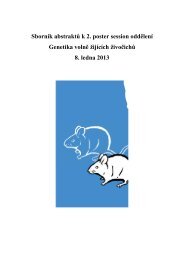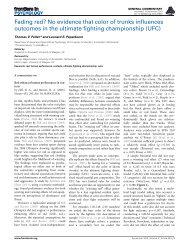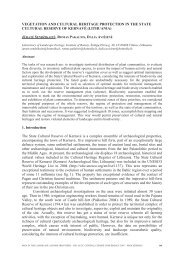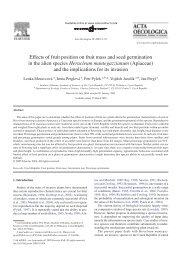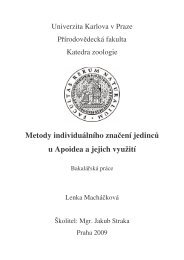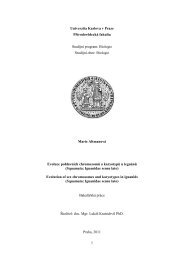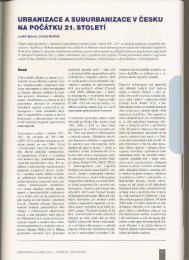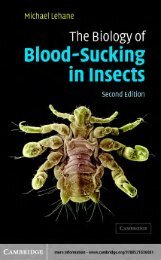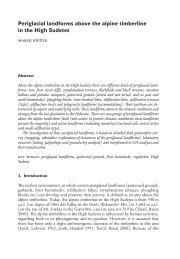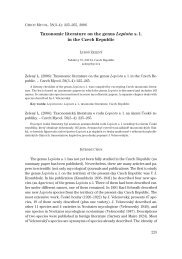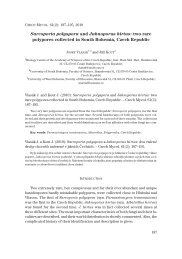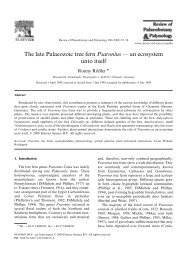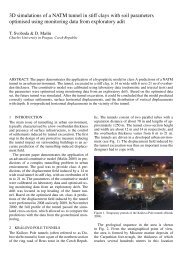Gymnopus obscuroides (Agaricomycetes, Omphalotaceae), a new ...
Gymnopus obscuroides (Agaricomycetes, Omphalotaceae), a new ...
Gymnopus obscuroides (Agaricomycetes, Omphalotaceae), a new ...
You also want an ePaper? Increase the reach of your titles
YUMPU automatically turns print PDFs into web optimized ePapers that Google loves.
CZECH MYCOL. 60(1): 13–19, 2008<br />
<strong>Gymnopus</strong> <strong>obscuroides</strong> (<strong>Agaricomycetes</strong>, <strong>Omphalotaceae</strong>),<br />
a <strong>new</strong> species of sect. Levipedes from England<br />
VLADIMÍR ANTONÍN 1 and NICK W. LEGON 2<br />
1<br />
Moravian Museum, Department of Botany, Zelný trh 6, CZ-659 37 Brno,<br />
Czech Republic; vantonin@mzm.cz<br />
26, Folly Fields, Yeovil, Somerset, BA21 4PH, UK; mykonik5@yahoo.co.uk<br />
2<br />
Antonín V. and Legon N. W. (2008): <strong>Gymnopus</strong> <strong>obscuroides</strong> (<strong>Agaricomycetes</strong>,<br />
<strong>Omphalotaceae</strong>), a <strong>new</strong> species of sect. Levipedes from England. – Czech Mycol.<br />
60(1): 13–19.<br />
A <strong>new</strong> species, <strong>Gymnopus</strong> <strong>obscuroides</strong> Antonín & Legon (<strong>Agaricomycetes</strong>, <strong>Omphalotaceae</strong>), is described.<br />
It is characterised by having a very long, floccose stipe, an initially dark purplish-brown then<br />
more mahogany-brown pileus, pallid pinkish-beige lamellae, rather large, subfusoid, ellipsoid-fusoid,<br />
lacrimoid to pip-shaped basidiospores, cylindrical, clavate, (sub)fusoid, subutriform, regular, irregular<br />
to subcoralloid cheilocystidia, a pileipellis consisting of radially arranged, cylindrical, scatteredly<br />
diverticulate, cylindrical, narrowly clavate or narrowly lageniform caulocystidia, and distinctly<br />
incrusted ochraceous-brown (in H O) hyphae, these becoming brown-olivaceous in KOH. It belongs to<br />
2<br />
sect. Levipedes (Fr.) Halling, subsect. Alkalivirentes Antonín & Noordel.<br />
Key words: Agaricales, <strong>Omphalotaceae</strong>, Alkalivirentes, <strong>Gymnopus</strong> <strong>obscuroides</strong>, <strong>new</strong> species,<br />
England.<br />
AntonínV. a Legon N. W. (2008): <strong>Gymnopus</strong> <strong>obscuroides</strong> (<strong>Agaricomycetes</strong>, <strong>Omphalotaceae</strong>),<br />
nový druh ze sekce Levipedes z Anglie. – Czech Mycol. 60(1): 13–19.<br />
Je popsán nový druh, <strong>Gymnopus</strong> <strong>obscuroides</strong> Antonín & Legon (<strong>Agaricomycetes</strong>, <strong>Omphalotaceae</strong>),<br />
vyskytující se na několika místech v jižní Anglii, ale nalezený i v dalších částech Velké Británie. Má<br />
velice dlouhý třeň, tmavě purpurově hnědý, pak mahagonově hnědý klobouk, světle růžově béžové lupeny,<br />
vločkatý třeň, dosti velké, téměř vřetenovité, elipsoidně-vřetenovité až kapkovité výtrusy, válcovité,<br />
kyjovité, téměř vřetenovité až urnovité, pravidelné, nepravidelné nebo až téměř korálovité cheilocystidy,<br />
pokožku klobouku složenou z paprsčitě uspořádaných, válcovitých, výrazně inkrustovaných<br />
hyf s řídkými krátkými bočními výrůstky, úzce kyjovité nebo lahvovité kaulocystidy; inkrustace je ve<br />
vodě okrově hnědá a zbarvuje se v KOH do hnědoolivova. Patří do sekce Levipedes (Fr.) Halling,<br />
podsekce Alkalivirentes Antonín & Noordel.<br />
INTRODUCTION<br />
During field research over the past few years, the second author made several<br />
collections of an interesting gymnopoid fungus, from widespread locations in<br />
southern England, and also discovered material from elsewhere in Britain, in<br />
herb. K. Much of this was originally determined as Collybia fuscopurpurea (Pers.)<br />
13
P. Kumm., or as ‘possibly Collybia obscura sensu Favre’ and was included in the<br />
Checklist of the British and Irish Basidiomycota under the former name (Legon<br />
and Henrici 2005).<br />
Whilst undertaking further studies for a <strong>new</strong> edition of the monograph of European<br />
marasmioid and collybioid fungi (Antonín and Noordeloos 2008), material<br />
was re-evaluated by the first author and, due to divergent morphological and anatomical<br />
characters, it was decided to describe this fungus as a <strong>new</strong> species belonging<br />
to the genus <strong>Gymnopus</strong> (Pers.) Roussel.<br />
MATERIAL AND METHODS<br />
Using an Olympus BX-50 light microscope with a magnification of ×1000, microscopic<br />
features are described from dried material mounted in Melzer’s reagent,<br />
Congo Red, H 2 O and KOH. For basidiospores, the factors E (quotient of length and<br />
width in any one spore) and Q (mean of E-values) are used. Authors of fungal<br />
names are cited according to Kirk and Ansell (1992), herbarium abbreviations follow<br />
Holmgren (2003).<br />
RESULTS<br />
<strong>Gymnopus</strong> <strong>obscuroides</strong> Antonín & Legon spec. nov. Figs. 1–3<br />
(MycoBank: MB511474)<br />
Pileo (5–)9–18(–25) mm lato, leniter convexo vel campanulato, postea applanato, juvenili<br />
purpureo-brunneo, mature mahagonio-brunneo. Lamellis densis, adnatis vel leniter decurrentibus,<br />
pallide roseo-griseo-albidis. Stipite usque 50–80 mm longo, cylindraceo, laterale compresso, floccoso,<br />
colore pilei simili. Basidiosporis (7,5–)8,5–11(–12) × (3,5–)4,0–5,0 μm, ellipsoideis-fusiformibus, subfusiformibus,<br />
lacrimoideis, hyalinis, inamyloideis. Basidiis tetrasporis. Cheilocystidiis 21–54 × 5,0–12(–15)<br />
μm, clavatis, cylindraceis, subfusiformibus, subutriformibus, regularibus vel irregularibus. Pileipellis<br />
ex hyphis cylindraceis, usque 8,0 μm latis, incrustatis, projectionibus cylindraceis vel anguste clavatis.<br />
Caulocystidiis 20–85 × 4,0–7,0(–9,0) μm, cylindraceis, anguste lageniformibus vel anguste clavatis,<br />
leniter crassiparietalibus. Incrustatione hypharum in KOH viride tincta. Hyphis fibulatis.<br />
Ho l o t y p u s (hic designatus): Anglia, Surrey, Windsor Great Park, Valley Gardens, 28. IX. 1998 leg.<br />
N. W. Legon (holotypus in herbario K(M) 61849, isotypus in herbario BRNM 705363 asservantur).<br />
P i l e u s (5–)9–18(–25) mm broad, initially shallowly ‘domed’ to almost<br />
campanulate, then expanded flat and often with a slightly upturned margin;<br />
smooth, dark purplish-brown when young, becoming more mahogany-brown<br />
when older, often with a paler ochraceous-brown margin in older or slightly dried<br />
out specimens; margin not striate. L a m e l l a e closely spaced, adnate with<br />
a slight tooth or (rarely) shallowly decurrent onto the stipe, pallid pinkish-beige,<br />
with a finely white-floccose, entire edge. S t i p e up to 90 mm long, often rather<br />
14<br />
CZECH MYCOL. 60(1): 13–19, 2008
ANTONÍN V. AND LEGON N. W.: GYMNOPUS OBSCUROIDES, A NEW SPECIES OF SECT. LEVIPEDES<br />
Fig. 1. <strong>Gymnopus</strong> <strong>obscuroides</strong>. a – cheilocystidia, b – basidiospores, c – caulocystidia, d – pileipellis<br />
hyphae. Scale bar = 20 μm.<br />
15
16<br />
CZECH MYCOL. 60(1): 13–19, 2008<br />
Fig. 2. <strong>Gymnopus</strong> <strong>obscuroides</strong>. England, Surrey, Windsor Great Park, Virginia Water, 24 Oct. 1991.<br />
Photo: N. W. Legon.<br />
Fig. 3. <strong>Gymnopus</strong> <strong>obscuroides</strong>. England, Surrey, Kew, Royal Botanic Gardens, 30 June 1998. Photo: N.<br />
W. Legon.
ANTONÍN V. AND LEGON N. W.: GYMNOPUS OBSCUROIDES, A NEW SPECIES OF SECT. LEVIPEDES<br />
obviously ‘out of proportion’ (very long) when compared to the diameter of the<br />
pileus, cylindrical, often slightly flattened and sometimes with a slight central furrow,<br />
sparsely covered with fine white flocci, floccose-hairy at the base, of a similar<br />
colour to the pileus; basidiomes completely pallid pinkish-brown colour when<br />
dried. C o n t e x t very thin, inodorous and with no obvious taste when fresh.<br />
B a s i d i o s p o r e s (7.5–)8.5–11(–12) × (3.5–)4.0–5.0 μm, E = 1.9–2.6(–3.0), Q =<br />
2.0–2.3, subfusoid, ellipsoid-fusoid, lacrimoid to pip-shaped, thin-walled, smooth,<br />
hyaline. B a s i d i a 26–33 × 7.5–9.0 μm, 4-spored, clavate, sometimes subcapitate.<br />
B a s i d i o l e s 15–35 × 2.5–10 μm, clavate, cylindrical or fusoid, sometimes<br />
subrostrate. C h e i l o c y s t i d i a 21–54 × 5.0–12(–15) μm, cylindrical, clavate,<br />
(sub)fusoid, subutriform, regular, irregular to subcoralloid, sometimes lobed or<br />
with projection(s), rarely branched or rostrate, thin– to slightly thick-walled,<br />
hyaline; rather variable in each specimen – with regular cystidia dominating in<br />
some specimens, or in others, coralloid ones. P l e u r o c y s t i d i a absent.<br />
Tr a m a l h y p h a e cylindrical to (sub)fusoid, ± thin-walled, smooth or incrusted,<br />
up to 12(–15) μm wide, incrustation ochraceous-brown in H 2 O becoming dirty<br />
brown-olivaceous in KOH. P i l e i p e llis a cutis consisting of radially arranged,<br />
cylindrical, scatteredly diverticulate, thin– to slightly thick-walled, distinctly<br />
incrusted (granular or zebroid), up to 10 μm wide hyphae, incrustation<br />
ochraceous-brown in H 2 O becoming (dirty) brown-olivaceous in KOH; lateral projection<br />
± digitate, often irregular to coralloid, thin-walled; terminal elements adpressed<br />
to erect, 20–50 × 4.5–6.0 μm, cylindrical, narrowly clavate to narrowly<br />
lageniform, sometimes (slightly) irregular, ± thin-walled, smooth. S t i p i t i p e llis<br />
a cutis of cylindrical, parallel, slightly thick-walled hyphae, up to 5.0 μm wide,<br />
with pale yellowish-ochraceous to olivaceous tinged walls in KOH. C a u l o -<br />
c y s t i d i a 20–85 × 4.0–7.0(–9.0) μm, cylindrical, narrowly clavate or narrowly<br />
lageniform, rarely branched, sometimes rostrate, obtuse, slightly thick-walled,<br />
with pale ochraceous-olivaceous walls in KOH. C l a m p c o n n e c t i o n s present<br />
in all tissues.<br />
Chemical reactions. Most parts of the basidiocarps are inamyloid and<br />
non-dextrinoid, with the exception of the incrustation on the hyphae of the trama<br />
and pileipellis, which are indistinctly dextrinoid.<br />
E c o l o g y. Saprotrophic; single or in small clumps amongst short grass on<br />
acidic soil in gardens, parkland or heathland vegetation.<br />
P h e n o l o g y. (June) September to November.<br />
D i s t r i b u t i o n. Seemingly rather frequent in southern England, with numerous<br />
collections from Surrey and Berkshire. Further collections, in herb. K, from<br />
other areas in England [Leicestershire, Middlesex (London), North Wiltshire and<br />
South Somerset] and a single one from Wales (Denbighshire).<br />
17
C o l l e c t i o n s e x a m i n e d. England, Surrey, Kew, Royal Botanic Gardens, 30 June 1998, N. W.<br />
Legon [K(M) 58031, BRNM 705366 and K(M) 58019, BRNM 705362]. – England, Surrey, Brookwood<br />
Cemetery (near Woking), 9 Oct. 2005, N. W. Legon [K(M) 133449 and BRNM 705365]. – England, Surrey,<br />
West End (near Bisley), Brentmoor Heath, 4 Oct. 1998, N. W. Legon [K(M) 61213 and BRNM 705360]. –<br />
England, Berkshire, Windsor Great Park, Saville Gardens, 29 Oct. 1989, N. W. Legon [K(M) 14088 and<br />
BRNM 705358]. – ditto, 8 Nov. 1989, N. W. Legon [K(M) 86881 and BRNM 705361]. – England, Surrey,<br />
Windsor Great Park, Virginia Water, 24 Oct. 1991, N. W. Legon [K(M) 18719 and BRNM 705359]. – ditto,<br />
28 Sept. 1998, N. W. Legon [K(M) 34624 and BRNM 705364]. – England, Surrey, Windsor Great Park, Valley<br />
Gardens, 28 Sept. 1998, N. W. Legon [holotype, K(M) 61849 and BRNM 705363].<br />
DISCUSSION<br />
<strong>Gymnopus</strong> <strong>obscuroides</strong> is characterised by a dark purplish-brown pileus, this<br />
more mahogany-brown with age, a floccose, and (in comparison with the diameter<br />
of the pileus) very long stipe, pallid pinkish-beige lamellae, basidiocarps becoming<br />
very pallid pinkish-brown when dried, rather large, subfusoid, ellipsoidfusoid,<br />
lacrimoid or pip-shaped basidiospores, cylindrical, clavate, (sub)fusoid,<br />
subutriform, regular, irregular to subcoralloid cheilocystidia, a pileipellis consisting<br />
of radially arranged, cylindrical, scatteredly diverticulate, cylindrical to narrowly<br />
clavate or narrowly lageniform caulocystidia, and distinctly incrusted<br />
hyphae, the incrustation ochraceous-brown in H 2 O but becoming brownolivaceous<br />
in KOH. These characters place it in sect. Levipedes (Fr.) Halling,<br />
subsect. Alkalivirentes Antonín & Noordel.<br />
In other <strong>Gymnopus</strong> species with hyphae turning greenish in alkalis, G. fuscopurpureus<br />
(Pers.: Fr.) Antonín, Halling & Noordel. has darker coloured basidiocarps,<br />
smaller basidiospores, (6.0–)6.5–8.5 × (2.5–)3.0–4.0(–5.0) μm, a pileipellis<br />
with a Dryophila-structure and is usually found on litter of Fagus, or rarely Pinus.<br />
<strong>Gymnopus</strong> loiseleurietorum (Moser, Gerholt & Tobies) Antonín & Noordel. is<br />
smaller in stature, has a translucently striate, chocolate-brown, then pallescent<br />
pileus, a shorter (20–30 mm long) stipe, smaller basidiospores (5.5–8.3 × 3.4–5.0<br />
μm), and lacks cheilocystidia. <strong>Gymnopus</strong> pubipes Antonín, A. Ortega & Esteve-<br />
Rav. has a chestnut-brown or purplish-brown then pallescent pileus (paler, brown,<br />
with pale cream, beige or whitish margin in var. pallidopileatus), 10–40 mm in diameter,<br />
with striate margin, smaller basidiospores, (5.0–)5.5–8.0 × 2.5–4.0 μm,<br />
smaller basidia (18–25 × 5.0–7.5 μm), and pileipellis with a typical Dryophilastructure<br />
(Antonín and Noordeloos 1997, 2008). <strong>Gymnopus</strong> potassiovirescens<br />
(Contu) Antonín & Noordel. has distinctly more robust basidiocarps (with the<br />
habitus of Rhodocollybia butyracea) and basidiospores of similar size (8.0–11 ×<br />
4.2–6.0 μm) but differing in shape (Contu 2000).<br />
Among extra-European species with similar characters, G. alkalivirens<br />
(Singer) Halling has a glabrous stipe, smaller basidiospores, 5.4–6.5(–8.6) ×<br />
18<br />
CZECH MYCOL. 60(1): 13–19, 2008
ANTONÍN V. AND LEGON N. W.: GYMNOPUS OBSCUROIDES, A NEW SPECIES OF SECT. LEVIPEDES<br />
2.2–3.2(–5.4) μm, and scattered or inconspicuous cheilocystidia (Halling 1983), G.<br />
virescens A. W. Wilson, Desjardin & E. Horak a similar habit but slightly different<br />
basidiospores (7.0–10 × 3.0–6.0 μm), shorter basidia (19–24 × 4.0–7.0 μm),<br />
pileipellis without terminal elements and lacks cheilocystidia (Wilson et al. 2004),<br />
G. semihirtipes (Peck) Halling possesses a glabrous or subglabrous stipe, smaller<br />
basidiospores, 7.5–8.6(–9.8) × 3.2–4.2(–5.0) μm, and lacks hymenial cystidia<br />
(Halling 1983), G. spongiosus (Berk. & M. A. Curtis) Halling a subglabrous stipe,<br />
smaller basidiospores (6.2–8.4 × 3.5–4.2 μm), smaller basidia (17.5–24.5 × 6.3–9.8 μm),<br />
and inconspicuous, differently shaped cheilocystidia (Halling 1983).<br />
ACKNOWLEDGEMENTS<br />
The authors wish to thank Zdeněk Pouzar (National Museum, Prague, Czech<br />
Republic) for correcting the Latin diagnose. The research of the first author was<br />
supported by the Ministry of Culture of the Czech Republic (MK00009486201).<br />
REFERENCES<br />
ANTONÍN V. and NOORDELOOS M. E. (1997): A monograph of Marasmius, Collybia and related genera in<br />
Europe. Part 2: Collybia, <strong>Gymnopus</strong>, Rhodocollybia, Crinipellis, Chaetocalathus, and additions<br />
to Marasmiellus. – In: Libri Botanici 17: 1–256, Eching.<br />
ANTONÍN V. and NOORDELOOS M. E. (2008): A monograph of marasmioid and collybioid fungi in Europe.<br />
– Eching (in press).<br />
CONTU M. (2000): Tre notevoli species di Collybia dalla Sardegna. – Boll. Gruppo Micol. Bres. 43(1):<br />
3–12.<br />
HALLING R. E. (1983): The genus Collybia (Agaricales) in the Northeastern United States and adjacent<br />
Canada. – Mycol. Mem. 8: 1–148.<br />
HOLMGREN P. K. (2003): Index herbariorum. – http://sciweb.nybg.org/science2/IndexHerbariorum.asp.<br />
KIRK P. M. and ANSELL A. E. (1992): Authors of fungal names. − 95 p. Kew.<br />
LEGON N. W. et al. (2005): Checklist of the British and Irish Basidiomycota. – 517 p. Kew.<br />
WILSON A. W., DESJARDIN D. E. and HORAK E. (2004): Agaricales in Indonesia. 5. The genus <strong>Gymnopus</strong><br />
from Java and Bali. – Sydowia 56(1): 137–210.<br />
19



